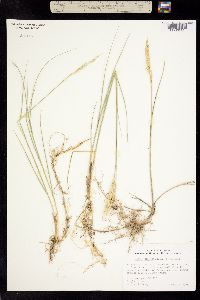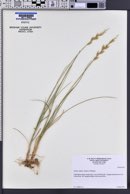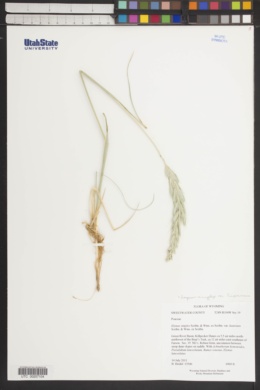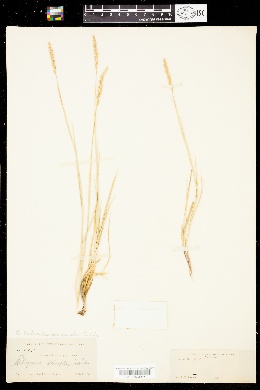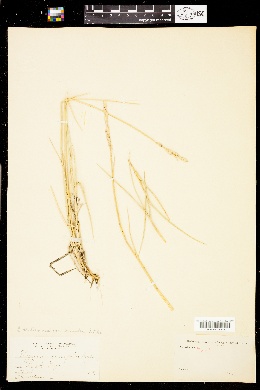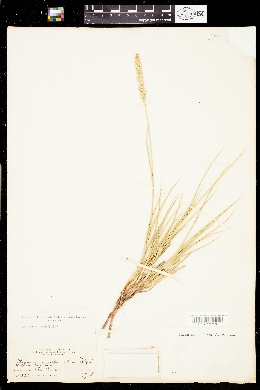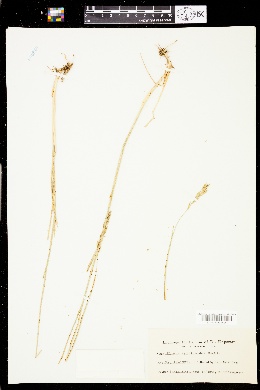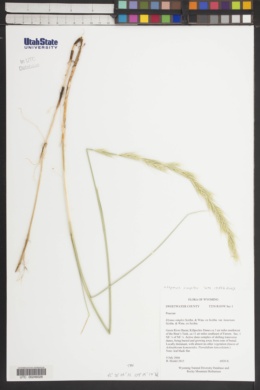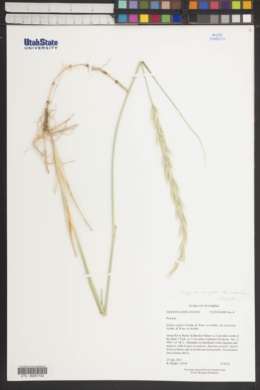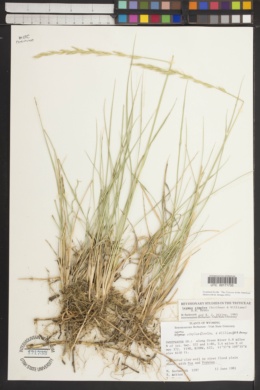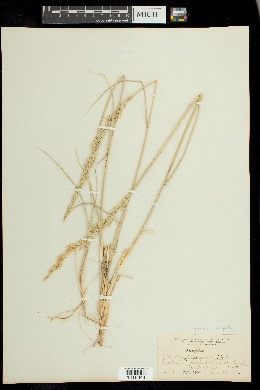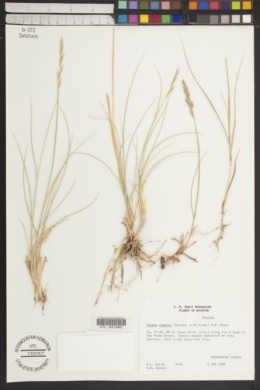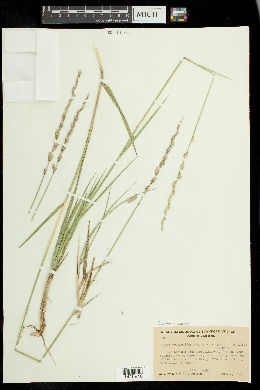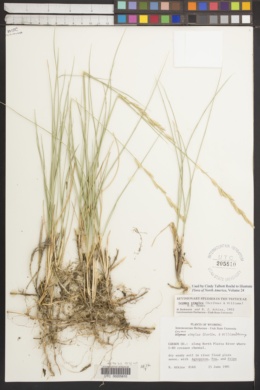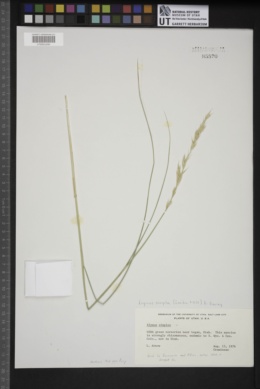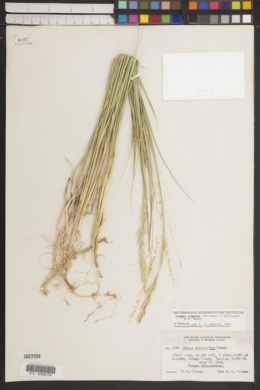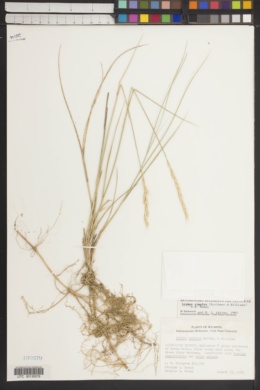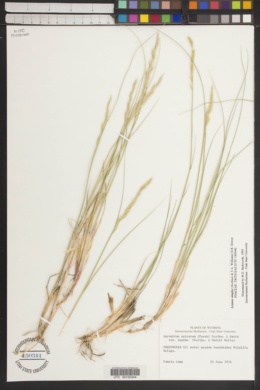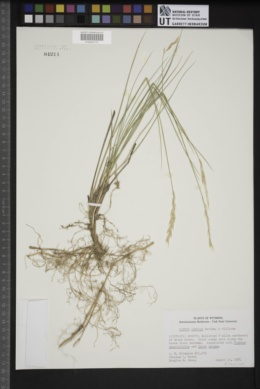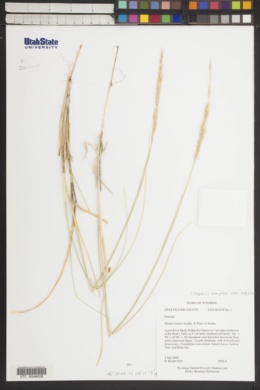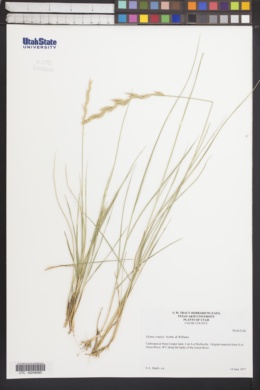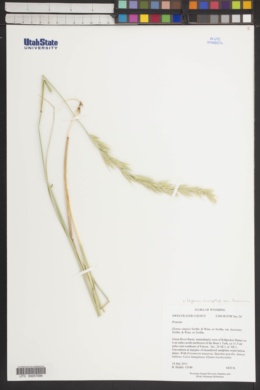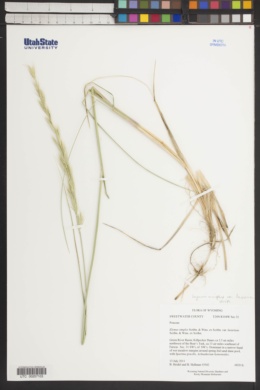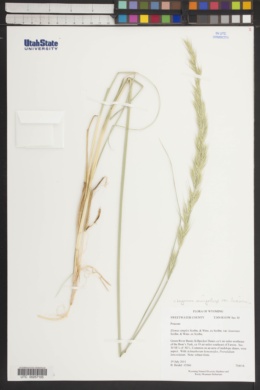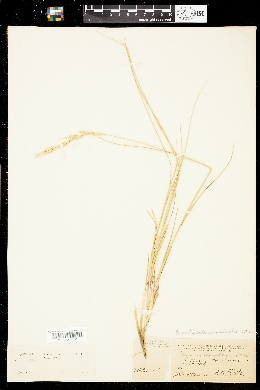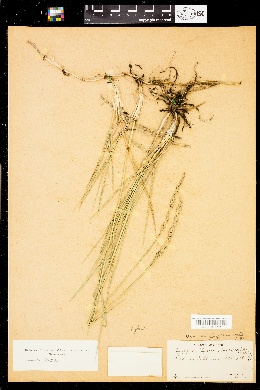Leymus simplex
|
|
|
|
Family: Poaceae
Alkali Lyme Grass, more...Alkali Wildrye
[Elymus simplex Scribn. & Williams, moreElymus simplex var. luxurians Scribn. & T.A.Williams, Elymus tricoides subsp. simplex (Scribn. & Williams) Á. Löve, Elymus tricoides var. simplex (Scribn. & Williams) A.S. Hitchc., Elymus triticoides subsp. simplex , Elymus triticoides var. simplex Hitchc., Leymus simplex var. luxurians (Scribn.) Beetle] |
Plants not cespitose, strongly rhizomatous, often glaucous. Culms 35-75 cm tall, 1-2.5 mm thick, solitary or a few together, glabrous or sparsely pubescent near the nodes. Leaves exceeded by the spikes; sheaths glabrous, smooth; auricles infrequently present, to 0.8 mm, the auricular location often with hairs to 2 mm; ligules 0.3-0.5 mm, truncate, erose; blades 4-29 cm long, 1-2(5) mm wide, flat, becoming involute when dry, stiff, adaxial surfaces scabrous, with scattered hairs to 2 mm, veins 7-11, subequal, prominently ribbed. Spikes 1.5-25 cm long, 4-10 mm wide, with 1 spikelet per node at midspike, sometimes with 2 at the lower nodes; internodes 7-12 mm, surfaces glabrous or strigillose, edges ciliate, cilia to 1 mm. Spikelets 16-25 mm, pedicellate, pedicels 1-2(5) mm, with 3-12 florets. Glumes subequal, 8-12 mm long, 0.5-1.5 mm wide, subulate, tapering from about 1/4 of their length, stiff, glabrous at least at the base, the central portion thicker than the margins, keeled, 0-1(3)-veined, veins inconspicuous at midlength; lemmas 7-12 mm, glabrous, awned, awns 2.3-6.5(12) mm; anthers 3.7-4.5 mm, dehiscent. 2n = 28. Leymus simplex is found in meadows and drifting sand in southern Wyoming, and along the Green River in northeastern Utah. Culms 55-75 cm tall, 2-2.5 mm thick. Spikes 10-25 cm long; internodes 10-12 mm. Spikelets 20-25 mm, with 6-12 florets. Leymus simplex var. luxurians grows at a few locations in Wyoming. It sometimes grows close to var. simplex. It may represent clones that have access to more water and/or more nutrients but the absence of intermediate plants suggests a genetic distinction. Perennials, Terrestrial, not aquatic, Rhizomes present, Rhizome short and compact, stems close, Rhizome elongate, creeping, stems distant, Stems nodes swollen or brittle, Stems erect or asc ending, Stems solitary, Stems terete, round in cross section, or polygonal, Stem internodes hollow, Stems with inflorescence less than 1 m tall, Stems, culms, or scapes exceeding basal leaves, Leaves mostly basal, below middle of stem, Leaves mostly cauline, Leaves conspicuously 2-ranked, distichous, Leaves sheathing at base, Leaf sheath mostly open, or loose, Leaf sheath smooth, glabrous, Leaf sheath and blade differentiated, Leaf blades linear, Leaf blade auriculate, Leaf blades very narrow or filiform, less than 2 mm wide, Leaf blades mostly flat, Leaf blade margins folded, involute, or conduplicate, Leaf blades mostly glabrous, Leaf blades more or less hairy, Leaf blades scabrous, roughened, or wrinkled, Leaf blades glaucous, blue-green, or grey, or with white glands, Ligule present, Ligule an unfringed eciliate membrane, Inflorescence terminal, Inflorescence simple spikes, Inflorescence a dense slender spike-like panicle or raceme, branches contracted, Inflorescence s olitary, with 1 spike, fascicle, glomerule, head, or cluster per stem or culm, Inflorescence single raceme, fascicle or spike, Inflorescence spikelets arranged in a terminal bilateral spike, Flowers bisexual, Spikelets pedicellate, Spikelets sessile or subsessile, Spikelets laterally compressed, Spikelet less than 3 mm wide, Spikelets with 3-7 florets, Spikelets with 8-40 florets, Spikelets solitary at rachis nodes, Spikelets paired at rachis nodes, Spikelets distichously arranged, Spikelets all alike and fertille, Spikelets bisexual, Spikelets disarticulating above the glumes, glumes persistent, Spikelets disarticulating beneath or between the florets, Rachilla or pedicel glabrous, Glumes present, empty bracts, Glumes 2 clearly present, Glumes equal or subequal, Glumes equal to or longer than adjacent lemma, Glumes awn-like, elongated or subulate, Glumes awned, awn 1-5 mm or longer, Glumes 1 nerved, Lemma coriaceous, firmer or thicker in texture than the glumes, Lemma 5-7 nerved, Lemma glabrous, Lemma apex acute or acuminate, Lemma distinctly awned, more than 2-3 mm, Lemma with 1 awn, Lemma awn less than 1 cm long, Lemma margins thin, lying flat, Lemma straight, Palea present, well developed, Palea about equal to lemma, Palea 2 nerved or 2 keeled, Palea keels winged, scabrous, or ciliate, Stamens 3, |

























